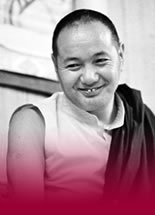Robina’s Blog
10 October, 2020
How do we get to realize the emptiness of the I? Am I supposed to just sit there and think, “I am empty, I am empty, I am empty,” waiting for some vision to come. Ridiculous!
Actually, you don’t sit there thinking about emptiness; you sit there thinking about dependent arising. And that thinking, that logical analysis, triggers the conclusion, “Oh, I see – therefore, there’s no I from its own side, therefore the I is empty of existing from its own side.” Emptiness is the conclusion you come to, having thought about dependent arising. It’s a very practical thing.
One way phenomena exist is in dependence upon their parts. There is a cup, but you won’t find cup apart from its parts. But we think there is, and our language cheats us. Our language is really tricky. It reinforces selfexistence.
Back in the seventh century, Chandrakirti, this Indian great commentator on Nagarjuna’s teachings on the Middle Way, which are at the heart of all the teachings on emptiness in Tibet, used the example of a chariot. “Well,” he said, “ in order to look for this inherent chariot that we think is there, let’s break it down into its component parts.”
Of course, the tastiest example is the self, the I. So let’s do this little analysis. First, remember, you have to establish the existence of the self conventionally: label it, define it, check that it fits its definition, that’s there’s no valid cognition that contradicts it. Then you’d do an analysis, you’d do it rigorously. You would start to break down the component parts of your own self – just like with the chariot – and you’d put them all out there in little piles. All the hard bits and the soft bits and the mucky bits and all the bits of conventional your mind – the negative states, the positive ones – as many piles as you want. Keep stripping it away, deconstructing this I into its component parts in this rigorous search among the parts of the self for the inherent self, which we’re so convinced is in there somewhere.
We believe totally that we’ll end up with this naked self-conscious little I that’s now been exposed, that’s the owner of all the parts. We talk like this: “I did not do this.” “I am a special person.” “I am so fat and ugly.” “I am not this.” “How dare you say that about me!” We really believe there’s a separate component in there that’s the basis of the name I or self that is, as my friend Pende puts it, walking hand in hand with the other components, the parts, the mind, the body, etc., etc. We believe there is this me in there that kind of runs the show, a mini-me, a landlord, the boss.
Even conventionally, the Consequentialist Middle Way view says you won’t find that one. Let’s do an exercise to prove it. Okay. I have a cup, a clock and a vase. Can you see this? So, how many phenomena did I mention? Me, the cup, the clock, the vase, right? Four phenomena. We’re talking conventionally here, nothing tricky. If it’s a true statement that I just made, you must point out four separate, distinct phenomena: you have to point out a table that is not a cup, not a vase, and not a clock, right? A clock that is not the table, the cup, the vase. Etc. You have to point out four separate phenomena. There’s a table, there’s a cup, there’s a clock, there’s a vase. You agree, don’t you? And we can do that, can’t we? Easy enough. Okay then.
Another statement: I have a nose, a hand, and a foot. You agree? How many phenomena did I mention? Three? No. There are four phenomena, aren’t there: I, nose, foot, hand. Do you agree? Same discussion. If those four phenomena do exist conventionally, you have to find four phenomena, each of which is distinct, is not the other, don’t you agree? If I say there’s a foot, I have to point out a foot that isn’t the other three phenomena: that’s common sense. And among four bits, we can do that: there’s a foot that is not the hand, is not the nose, and is not the I.
Well, there’s my foot – cut it off! There’s my nose – you can have it! There’s my hand. Now, where’s the I? Where is the piece called I that is not the nose, not the hand, and not the foot. You keep deconstructing and all you’ll end up with is thousands of bits – and not one of them is called I!
The grossest level of no-self that Buddha initially argues with is the view that there is a permanent, partless self separate from everything else: unchanging and unitary. The lower Buddhist schools of thought take this view as gross selflessness.
The next level of selflessness, which is subtle selflessness for all the lower schools, is that there is no substantial, self-sufficient self. But they all end up positing that there has to be something there among the parts that is called I, each of them positing something different.
The Consequentialist Middle Way view says no, there isn’t; there doesn’t need to be. For them, the truth is that there is no inherent I; that from the side of the parts – because there is nowhere else there could be an I – there is not an iota of anything that makes it that self. Everything exists like that, they say. This is the most radical, the scariest view! And it’s what leads to the subtlest level of dependent arising, that the self is merely labeled.
As His Holiness says, the I is not empty because you can’t find it – and you can’t; that’s not the real premise. The I – and everyting else – is empty because it’s a dependent arising.
Cup is merely a name the mind imputes upon the parts, which is the valid base for that label: the handle, the base, the clay, the this, the that. “Robina” is a name we impute upon the parts of Robina: the aggregates: the body and mind. Our instinct is almost to then think, “Oh, good there are the parts, there is something!” No. Body is a name imputed by the mind upon its parts; mind is a name imputed upon its parts. Same discussion – you can’t find a handle among the parts of the handle, because “handle” is merely a name imputed on its parts. You can’t find a hand among the parts; it is a hand, it does hold a cup, but it’s merely a name imputed by mind upon the valid base, which is the fingers and the thumb and the palm and the wrist, etc. Everything exists like this.
Prison is made up by our mind; love, anger, jealousy, hell, enlightenment: they all exist in dependence upon the mind calling them that, buying into their being that. But nevertheless they do function as that: as prison, a cup, a self, anger. They must in order to establish them as conventions. You can’t call a cup a knife, just because you feel like it. You have to establish it conventionally, and it has to function, and we have to agree to it. But ultimately you can’t find it.
Putting these two truths together is the tricky job to be done. As Lama Zopa Rinpoche says, “When we have realized emptiness, realized how things actually exist, it’s as if there is nothing there, but there is. But what exists is so subtle it’s as if it’s an illusion, it’s as if it doesn’t exist.” Or, as we’d say in the West, “It’s all smoke and mirrors.”
When we have realized the emptiness of that fantasy I, as Rinpoche says, “Then there is no fear.” Fear is finished, because fear is the main emotion of all the delusions, in particular ego-grasping.
How amazing! Something to look forward to.

